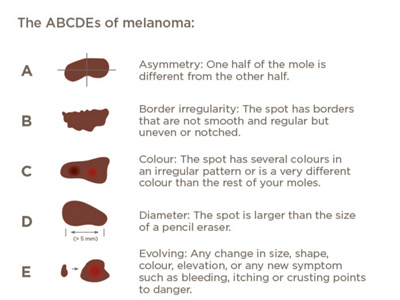Because most melanomas occur on the skin where they can be seen, patients themselves are often the first to detect many melanomas. Early detection and diagnosis are crucial. Caught early, most melanomas can be cured with relatively minor surgery. The likelihood that the melanoma will come back or spread depends on how deeply it has gone into the layers of the skin. For melanomas that come back or spread, treatments include chemo and immunotherapy, or radiation therapy.
Nobody can diagnose him or herself. If you notice a spot that looks as though it is new or changing, have it checked by a doctor. When it comes to spots on the skin, it is always better to be safe than sorry.

Factors that raise your risk for melanoma include:
- Caucasian (white) ancestry
- Fair skin, light hair, and light-coloured eyes
- A history of intense, intermittent sun exposure, especially in childhood
- Many (more than 100) moles
- Large, irregular moles
- Close blood relatives -- parents, siblings and children -- with melanoma
Slow daily sun exposure, even without burning, may also substantially raise your risk of skin cancer.
The best way to know your risk level is to have a dermatologist perform a full body examination.
The main types of melanoma are:
- Superficial spreading melanoma: This type accounts for about 70% of all cases of melanoma. The most common locations are the legs of women and the backs of men, and they occur most commonly between the ages of 30 and 50, though melanomas can occur in other locations and at other ages as well. These melanomas are often barely raised and have a variety of colours. Such melanomas evolve over one to five years and can be readily caught at an early stage if they are detected and removed.
- Nodular melanoma: About 20% of melanomas begin as deeper, blue-black to purplish lumps. They may evolve faster and may also be more likely to spread.
- Lentigo maligna: Unlike other forms of melanoma, lentigo maligna tends to occur on places like the face, which are exposed to the sun constantly rather than intermittently. Lentigo maligna looks like a large, irregularly shaped or coloured freckle and develops slowly. It may take many years to evolve into a more dangerous melanoma.
What methods are available to help prevent melanoma?
Reducing sun exposure: Avoiding sun exposure is the best means of helping to prevent melanoma, followed by wearing hats and tightly woven clothing, followed by broad-spectrum waterproof sunscreens applied liberally and often.
Early detection: Get your skin checked at least once. Then, if it is recommended, have your skin checked on a regular basis.
Screening of high-risk individuals: Anyone at high risk, such as those with a close relative who has melanoma, should be screened by a doctor.
